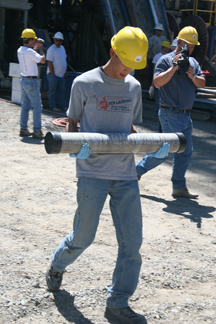|
Web Extra Friday, October 5, 2007
Looking deep into the heart of a fault
 Mark Zoback |
| Stanford University graduate student Hiroki Sone cradles a section of core from a 3.2-kilometer-deep borehole that intersects part of the San Andreas Fault. The core offers scientists their first chance to look deep into an active fault. |
The long-held secrets of one of the world's most infamous active fault zones are, at last, being revealed. On Sept. 7, scientists recovered a core of rock from a 3.2-kilometer-deep borehole that passes right through part of the San Andreas Fault Zone. The traces of the fault zone displayed in the core can tell fascinating stories about the fault's history and behavior, scientists think — and may get them closer to understanding exactly why and how earthquakes occur around the world.
Scientists working with the San Andreas Fault
Observatory at Depth (SAFOD), a multimillion-dollar project that is part
of Earthscope — which is itself funded by the National
Science Foundation (NSF) and run jointly with the U.S. Geological Survey (USGS)
— are breathing a sigh of relief after the successful recovery of the core.
The borehole was drilled into a segment of the fault zone near Parkfield, Calif.,
that has been much-studied because it moves slowly and steadily, producing microearthquakes
rather than powerful temblors. The culmination of a project that has been planned
for 15 years, it's the first time scientists have been able to look deep into
an active fault.
Getting the core out wasn't easy, however. "We had a
long and difficult summer," said Mark Zoback, a geophysicist at Stanford
University in Palo Alto, Calif., and one of the SAFOD project's three principal
investigators, at a press conference Thursday. The first two phases of the SAFOD
project, which involved drilling the full length of the borehole on an incline
across the San Andreas Fault near Parkfield, had already been completed successfully
in 2004 and in 2005. But Phase 3 — actually recovering a core of rock from
the borehole — was considerably more difficult.
"This year, the San Andreas decided to fight back,"
Zoback said, laughing. After nine weeks of alternating successful core retrieval
and frustrating equipment snafus, however, the team extracted the last piece
of core from the borehole at about 3 a.m. on Sept. 7 — and the scene was
something out of a Hollywood movie, he said. "We were in a lightning and
thunderstorm of historic proportions. But there was nothing that was going to
keep us from bringing that core out. It was like the San Andreas Fault was giving
up its secrets — but not easily."
In all, the team retrieved more than 40 meters of rock core
weighing about a ton. Once the team had the core safely on deck, "there
was not only elation, but a great sense of accomplishment," said William
Ellsworth, a scientist with the USGS Earthquake Hazards Team
in Menlo Park, Calif. Some surprises were immediately apparent. For example,
scientists had speculated that the parts of the core containing "fault
gouge" — rocks that delineate a fault zone and have been churned up,
cracked, deformed or even polished by the fault's intense shearing forces —
would be only a few centimeters wide, but the team instead discovered that the
fault gouge, which marked two broad fault zones crossed by the core, were as
much as one and two meters across.
Equally exciting was that the fault gouge contained blobs
of serpentine, a metamorphosed oceanic crustal rock that can chemically alter
to the soft mineral talc. Scientists have long suspected that supple serpentine
(or, they now suspect, talc) might help control whether a fault zone moves slowly
and steadily and produces smaller earthquakes, or whether the walls of a fault
will lock in place periodically before releasing that energy as a powerful,
devastating giant earthquake (see Geotimes, October
2007).
Serpentine had been seen at the surface in fault zones, but
without any direct evidence of what rocks were down in the fault itself, the
role of serpentine was only an idea, said Stephen Hickman, also on the USGS
Earthquake Hazards Team in Menlo Park. "To people looking at outcrops their
entire lives, [seeing the serpentine] was nothing short of inspiring,"
he said. "Seeing these cores coming from depth that are only a few hours
old and from a fault that's still moving — [it] is really a remarkable
opportunity."
With the valuable core safely retrieved, a bidding war, or
"sample party," among scientists to obtain pieces of the core for
study will take place in December, after which a special NSF committee will
decide how to divvy them up. SAFOD anticipates hundreds, if not thousands, of
requests for core samples.
"It's kind of like moon rocks, to people studying earthquake
mechanics," Hickman said. "The good news is that we have a lot of
fault gouge to hand out. But it'll have to be handled very carefully to get
the most amount of science we can from the core."
Links:
San
Andreas Fault Observatory at Depth (at Earthscope)
Earthscope
(Main page)
Stanford
University's Department of Geophysics
USGS
Earthquake Hazards Team
"Talc
may reduce friction at creeping fault," Geotimes, October 2007
Back to top

 Subscribe
Subscribe


